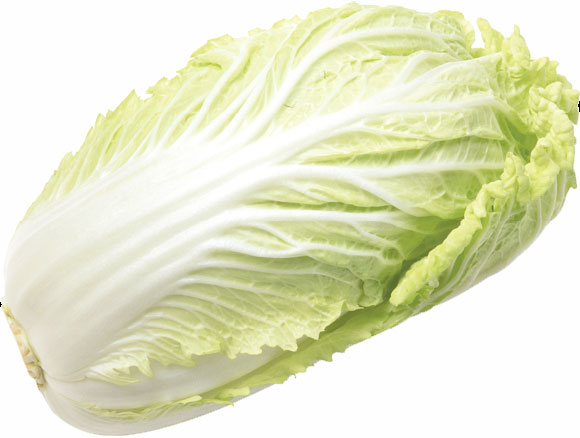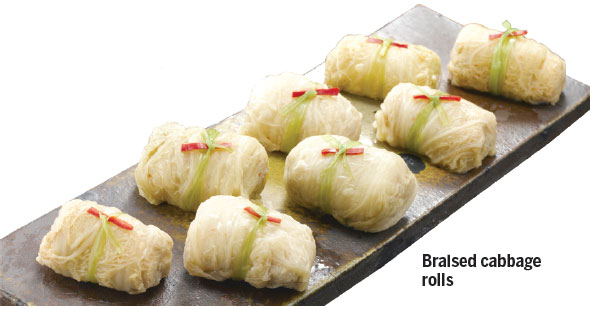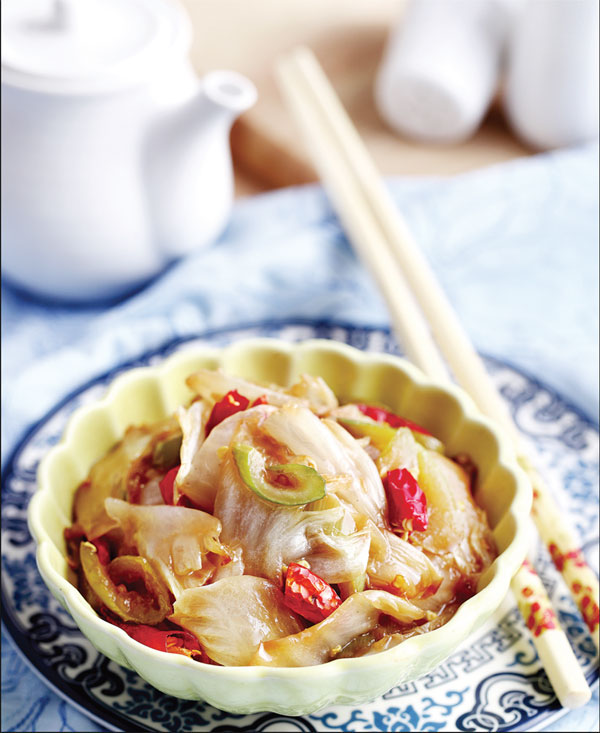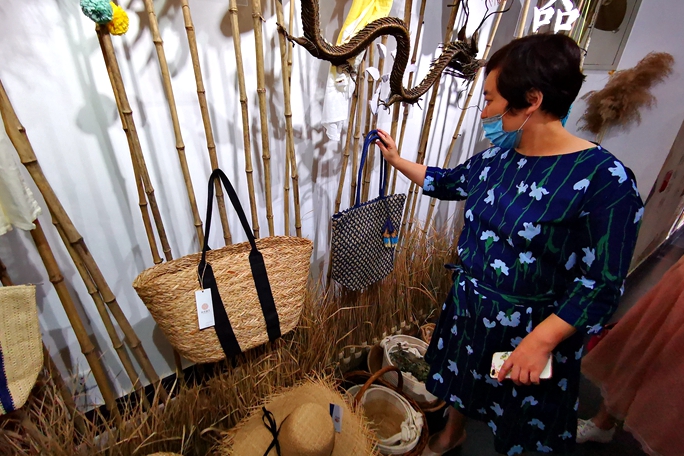Where cabbage is king
Editor's note: Traditional and fusion cooking styles, regional and international ingredients and a new awareness of healthy eating are all factors contributing to an exciting time for Chinese cuisine. We explore the possibilities.
An emperor and his favorite consort used to admire a delicately carved ornament made of jade that was probably part of her dowry. It is a miniature head of humble cabbage, with a crisp white base and translucent frilled green leaves with two tiny insects resting on the vegetable.
The emperor was Guangxu of the Qing Dynasty (1644-1911), and this famous piece of jade is called the Jade Cabbage, currently one of the main exhibits of the Palace Museum in Taipei. It was taken from Yonghe Palace in the Forbidden City, the imperial quarters of the consort Jinfei.
|
Stir-fried cabbage with vinegar and dried pepper. Provided to China Daily |

This exquisite and valuable piece of art lauds one of the most common vegetables in China, while representing wishes for good harvests and fertility.
The Chinese cabbage is planted all over China, in all seasons, but it is in the cold northeastern provinces that it grows large and sweet and tender, and plays a starring role in the cuisine.
Whole cabbages are bought and stored for the long winter months, piled outside in courtyards and on balconies. Together with the huge Shandong leeks, it is one of the vegetables that will fill the winter larder.
Huge truckloads of white cabbages roll into Beijing around October and November, plentiful and cheap. So cheap, in fact, that "as affordable as white cabbages" has become a popular term for a great bargain.
Wise housewives load their shopping trolleys full of huge cabbages, often topped with a super huge bunch of leeks.
The vegetables are carted home and neatly arranged on the balcony, or in a sheltered part of the garden. Sometimes an old blanket is thrown over the pile to deter open thievery by either the two-legged or four-legged.
This has been a winter ritual for a very long time, from when times were hard and logistics were limited.
Sometimes, cabbages are pickled.
They are soaked in brine and fermented in huge vats as suancai, the "sour vegetables" that dongbei cuisine revolves around. This is especially common in Liaoning and Heilongjiang provinces.
The yingcai or "hard dishes" of the northeast are hearty offerings such as thick slices of fatty pork belly stewed with roughly shredded pickled cabbage, or huge pots of sweet potato noodles cooked with more fermented cabbage.
In our Beijing household, traditions die hard, and the pile of cabbages in the yard is slowly reduced by daily soups and stir-fries. I have succeeded in sneaking in carrots and tomatoes to add some color to the winter diet.
The dabaicai cabbage is amazingly versatile.
It can be finely sliced and tossed with vinegar, sesame oil and a pinch of sugar for a crisp and refreshing salad. A bunch of blanched mung bean noodles provide the tactile contrast. This is especially appreciated deep in winter, when fresh salads are hard to come by.
Cut into chunks and cooked with carrots in a bone marrow stock, it turns into a tender vegetable stew to please the toothless old lady in the house, and is enjoyed just as much by those with a full set of teeth. Stewed cabbage retains its sweetness and is one of the few leafy vegetables that can withstand long cooking without losing color and taste.
The spouse's favorite is to have a pile of blanched cabbage with his zhajiangmian, dry-tossed noodles with hot bean sauce. The blanched vegetables lighten the heavy, savory noodles and make the dish a healthier option.
Sometimes, I remember my southern Chinese roots and cook a vegetarian special with a base of braised cabbage, with mushrooms, ginkgo nuts, lotus seeds, peas and carrots on top.
Another dish is tender braised cabbage hearts in thick chicken stock and top of milk or cream. This is straight from the imperial kitchens, and only the sweetest, most tender hearts of the cabbage are used.
It is sweet on sweet, with the natural flavor of the cabbage accentuated by the chicken stock and shredded dried scallops. That touch of cream gives the dish a velvety smoothness that takes it to another level.
I also like making Russian-inspired cabbage rolls with Chinese cabbage instead of round cabbages. For one thing, the leaves are larger and more pliable, and they do not melt into nothingness.
Chinese cabbage is also known as Napa cabbage in the West, after migrant Asian farmers introduced this vegetable to the San Francisco farmers' markets from their farms in Napa Valley across the Bay.
All very well, but I do think it's about time we reclaim the name, in recognition of Chinese cabbage's unique contribution to the Middle Kingdom's cuisines all these thousands of years.
paulined@chinadaily.com.cn

Recipe
Vegetarian cabbage wraps
1 large head of cabbage
200 g dried shiitake mushrooms, soaked and sliced
1 carrot, peeled and shredded 1 can bamboo shoots, shredded
1 can or eight freshly peeled water chestnuts, minced
1 tablespoon yellow fermented bean sauce, huangdoujiang
1 teaspoon sesame oil
Salt and a bit of sugar to taste
1 liter mushroom stock
Blanch the whole cabbage and carefully remove the large outer leaves. Take out the short tender heart of cabbage and finely chop it up.
Heat vegetable oil in a large frying pan and add the yellow fermented bean sauce. Fry till fragrant, then add sliced mushrooms, minced water chestnuts, shredded bamboo shoots and carrot. When the mixture is well seasoned, add the chopped cabbage. Season with sesame oil, salt and sugar to taste .
Fry the ingredients until the mixture is relatively dry and the vegetable juices are reabsorbed. Cool.
Spread out each large cabbage leaf and place a generous spoon of fried ingredients on the stem end. Roll up like an envelope and place the roll at the bottom of a shallow nonstick pot. Continue to pack the rolls into the pot until the cabbage leaves and ingredients are used up.
Pour the liter of mushroom stock into the pot and slowly let it simmer for an hour. This is a delicious vegetable dish with so much sweetness and bite, you won't miss the meat.
Braised Chinese cabbage with Chinese ham
1/2 a head of Chinese cabbage, about 1 kg
100 g Chinese ham from Jinhua, shredded
100 g fresh shiitake mushrooms, thinly sliced
2-3 thin slices ginger, slivered 1 liter chicken stock
Cut the Chinese cabbage into 5-cm chunks, rinse and drain.
Heat up two tablespoons of oil in a wok and add the ginger julienne. Fry till fragrant, then add the shredded Chinese ham.
Add the sliced mushroom next. Add the cabbage chunk and give them a good toss so the ingredients are evenly mixed.
Pour in the chicken stock and bring to a boil. Allow to rapidly boil, then reduce the heat and cover the pan
When the sauce is reduced and the vegetables are tender, check the seasoning and adjust to taste.
This is a great dish to serve the same day, but the flavors will mature and bloom even better the next day.
(China Daily European Weekly 03/30/2018 page18)


 Shandong Culture and Tourism Consumption Season
Shandong Culture and Tourism Consumption Season Culture, tourism sectors pick up in Shandong as epidemic wanes
Culture, tourism sectors pick up in Shandong as epidemic wanes

